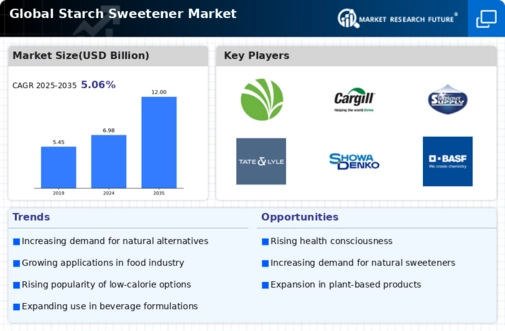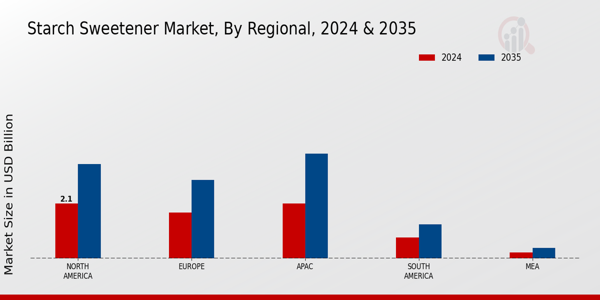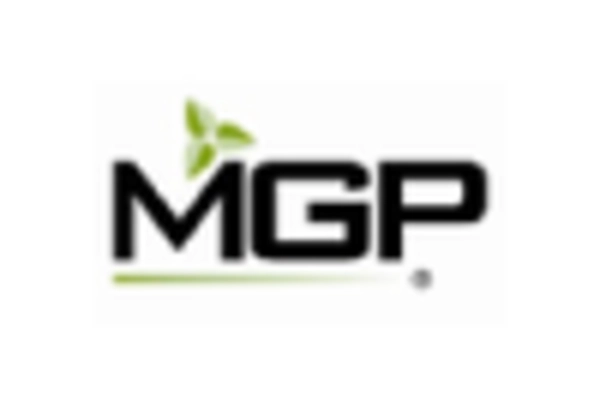Growing Awareness of Health Benefits
The increasing awareness of the health benefits associated with starch sweeteners is propelling The Global Starch Sweetener Industry forward. Research indicates that these sweeteners can offer lower glycemic responses compared to traditional sugars, making them appealing to consumers managing blood sugar levels. This awareness is particularly pronounced among diabetic individuals and those seeking healthier dietary options. Market data suggests that the demand for low-glycemic products is on the rise, with a projected increase of 7% in the next few years. As consumers become more educated about the nutritional advantages of starch sweeteners, manufacturers are likely to capitalize on this trend by promoting their products as healthier alternatives. Consequently, The Global Starch Sweetener Industry is expected to benefit from this growing consumer consciousness.
Rising Demand for Natural Sweeteners
The increasing consumer preference for natural ingredients is driving The Global Starch Sweetener Industry. As health-conscious individuals seek alternatives to artificial sweeteners, starch-based sweeteners are gaining traction due to their natural origins. This shift is reflected in market data, indicating a projected growth rate of approximately 5% annually over the next five years. Consumers are increasingly aware of the health implications associated with synthetic additives, leading to a surge in demand for products that utilize starch sweeteners. Manufacturers are responding by reformulating existing products to incorporate these sweeteners, thereby enhancing their market appeal. This trend not only aligns with consumer preferences but also positions The Global Starch Sweetener Industry favorably in a competitive landscape.
Technological Advancements in Production
Innovations in production technologies are reshaping The Global Starch Sweetener Industry, enhancing efficiency and product quality. Advances such as enzymatic processes and fermentation techniques are enabling manufacturers to produce starch sweeteners with improved characteristics, including higher purity and better solubility. These technological developments are not only streamlining production but also reducing costs, which may lead to more competitive pricing in the market. Furthermore, the integration of automation and data analytics in manufacturing processes is expected to optimize supply chain management, thereby increasing overall productivity. As a result, The Global Starch Sweetener Industry is poised for growth, as companies leverage these advancements to meet rising consumer demand for high-quality sweeteners.
Regulatory Support for Natural Ingredients
Regulatory frameworks that favor the use of natural ingredients are positively impacting The Global Starch Sweetener Industry. Governments and health organizations are increasingly endorsing the use of starch-based sweeteners as safer alternatives to artificial additives. This regulatory support is evident in various regions, where policies are being implemented to encourage the use of natural sweeteners in food products. Market analysis indicates that this trend is likely to foster growth, as manufacturers align their product formulations with regulatory guidelines. The Global Starch Sweetener Industry stands to gain from this supportive environment, as companies are incentivized to innovate and expand their offerings in compliance with evolving regulations.
Expansion of Food and Beverage Applications
The versatility of starch sweeteners is contributing to their widespread adoption across various food and beverage applications, thereby influencing The Global Starch Sweetener Industry. These sweeteners are utilized in a range of products, from baked goods to beverages, due to their functional properties such as texture enhancement and moisture retention. Market analysis suggests that the beverage segment alone is expected to account for a significant share, with a projected growth rate of 6% in the coming years. This expansion is driven by the increasing demand for low-calorie and sugar-free options, prompting manufacturers to explore innovative formulations that incorporate starch sweeteners. As a result, The Global Starch Sweetener Industry is likely to witness a diversification of product offerings, catering to evolving consumer preferences.


















Leave a Comment